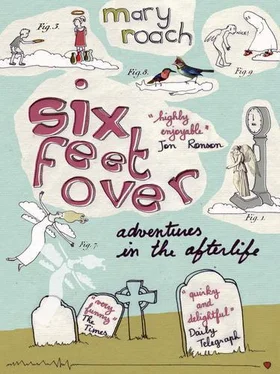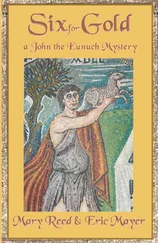Hereward Carrington read the book and, being Hereward Carrington, couldn’t resist building a set of Matla cylinders of his own. His model was accessorized with a bell, rigged to ring whenever the alcohol drop moved. Carrington would assemble a group of observers in a room with the device, ask for quiet, and then announce loudly, as though man-force had hearing trouble: “If there be any force present capable of entering the cylinder and thus displacing air, will it please do so?” Sometimes the alcohol drop moved, but not necessarily in conjunction with a request to do so. Often repeated requests were made and nothing happened. Then Carrington would give up and leave the room, only to hear the bell ring. It was as though the entity were intentionally making Carrington look like a boob in front of whichever fetching young lab assistant was at his side. Carrington spent an entire year messing about with the cylinders. In the end, he concluded that temperature changes and coincidence accounted for Matla’s results.
The amazing thing about men like Matla and Carrington is that they weren’t perceived as fringe scientists. For a significant span of years, paranormal research was an accepted undertaking among respectable scientists. As proof, I offer an article that ran in the July 30, 1921, Lancet , then and now one of the most respected medical journals in the world. A Dr. Charles Russ writes that he has proved the existence of an unknown “force or ray” that “emerges from the human eye.” Russ built a tabletop device to demonstrate this force, which is illustrated in the article. Volunteers were asked to stare into a sealed box at a copper-wire solenoid suspended from a string and held steady by magnetic force. If they stared at the left side of it, he claimed, the solenoid would be pushed clockwise; right-side staring set it twisting the other way. He posited that the mystery force “disturbs the electrostatic state of the enclosed system” and claimed that five physicists with London’s Royal Society were unable to find any electrical or mechanical fallacy that could account for the effects. Meanwhile, it’s business as usual on the facing page, with dysentery expert W. S. Dawson holding forth on fecal sampling—whether it is preferable to “introduce the swab” into the rectum or to take a specimen directly from “the motion.” [19] I’m trying to work out how this makes sense as a noun meaning “the product of a bowel movement.” This is not Dawson’s personal euphemistic misstep; the usage persists in medical writing today. Should you have had the misfortune of visiting a web page called the Constipation Page, you will have seen the phrase, “the motion or stool is very dry or hard.” Perhaps this is why the term “motion pictures” was replaced by “movies.” Now that I see it on the page, “movie” would have been a far better BM euphemism than “motion.” I’d love to chat, but I need to make a movie .
As for Dr. Russ’s machine, I can’t explain what was going on; however, given that no one has since replicated the study, I suspect it was a load of motion.
Dr. Russ was but one of a long parade of scientists who were convinced that the soul was a sort of life force that—if not actually photographable or locatable as an entity—could be detected and proved indirectly, by way of its emanations. Often these emanations were captured as coronal glows or lightninglike rays around the perimeters of living objects placed in contact with a photosensitive surface. Bear in mind, photography was in its infancy; its processes were still poorly understood. While some of the manipulations were outright fraud, most were the result of sincere, if misguided, efforts.
For instance, the effluviograph. In 1897, a team of scientists from the Société de Biologie in Paris demonstrated a new technique in which a halo could be made to appear on a photographic plate where a subject had held his finger. The men assumed they had discovered a way to capture od rays. Od force had been making the rounds as the latest form of life force, having bumped aside Franz Mesmer’s animal magnetism. In reality, what the French biologists had discovered was the effects of heat on photographic developer. As proof, chemist and debunker Emil Jacobsen produced an effluviograph that looked identical to the Parisian fingertip effluviographs but was made by touching the plate with the rounded end of a heated glass test tube.
Jacobsen’s next undertaking was to unseat the electrograph. In Beyond Light and Shadow , Rolf Krauss’s admirable history of paranormal photography, you will find a reproduction of an 1898 photograph entitled: “Electrograph of the antipathy between two Vienna sausages.” The photo was part of Jacobsen’s paper debunking electrographs, which do no more than document the light from an electrical discharge given off by an object—living, dead, or inert—that has been hooked up to an induction machine and placed in contact with a photosensitive surface. Using this technique, a member of the Imperial Institute for Experimental Medicine in St. Petersburg had claimed to be able not only to photograph the life force, but to use these images to diagnose illnesses and emotional states. The scientist paraded a photograph of two adversaries holding their fingertips close together—the inspiration for Jacobsen’s satirical Vienna sausage series—such that their sparks of nerve force could be seen to keep their distance, whereas nerve force among friends could be seen to commingle.
But electrographs did not go away. They were resurrected in the 1950s by a Russian couple named Semyon and Valentina Kirlian. Kirlian photography eventually became known as aura photography and to this day maintains a presence at psychic fairs. Interestingly, the Kirlians—despite sounding like a robe-wearing doomsday cult—never claimed that they’d found a way to photograph the soul or the astral body or what have you. Both the Kirlians and subsequent Kirlian-inspired parapsychologists—including a pair at UCLA—noticed a lot of variation in people’s “auras,” both from subject to subject and from hour to hour with the same subject. For this reason, they surmised that the photographs might prove a useful diagnostic tool. To figure out what it was they were diagnosing, the UCLA team hooked subjects up to induction machines and exposed them to all manner of physical and emotional stimuli. They were given drugs, plied with alcohol, asked to meditate, pissed off, frightened, and hypnotized. Although differences were observed from photo to photo, no useful patterns were found. Science stepped away from aura-reading, and the New Age—aided by the invention of color photography—stepped in.
The most famous Kirlian photograph is of a leaf with a missing tip, taken by Russian parapsychologists circa 1970 and presented as evidence of a sort of astral body made up of “bioplasma substance.” A glowing outline of the entire leaf, including missing tip, appears in the photo. I’m too undone by the concept of trees having astral bodies to register much of an opinion on the Russians’ work, though I can tell you that at the time Krauss’s book went to press, no one claimed to have reliably reproduced the phenomenon.
You will not be surprised to learn that Hereward Carrington did some aura research of his own. (This was the 1920s, long before the Kirlians had brought photography to bear on the subject.) In The Story of Psychic Science , he mentions that his “experiments with Negroes” seemed to suggest that the aura was either a subjective impression or an optical effect. I could find no details of Carrington’s aura experiments, and that is probably for the best.
And then came ectoplasm—Macdougall’s soul substance at last revealed. Ectoplasm debuted in 1914, in a series of bizarre photographs in an equally bizarre but briskly selling book called Phenomena of Materialization . By 1922, it was the stuff of major newspaper headlines. I can say with the steely confidence of someone who has reported on Vienna sausage emanations that no stranger episode ever beset the march of science.
Читать дальше











